How To Choose a Fiskars Axe (compared with pics)

Fiskars axes are a great choice, but it can be hard to know which to get because they have so many models. And they don’t do a great job helping people tell them apart.
I actually own (almost) every type of Fiskars axe, so hopefully, by the end of this, you will know which you need. Here is a quick summary:
| Axe Model | Head | Length | Use |
|---|---|---|---|
| X27 36″ Black | Split | 36″ | Primary splitting axe (most power) |
| X25 | Split | 28″ | Primary splitting axe (more mobile) |
| X21 28″ Black | Split | 28″ | Mid-size splitter or youth axe |
| 28″ Black | Chop | 28″ | General work axe |
| X17 | Split | 23.5″ | Compact splitter |
| X15 | Chop | 23.5″ | Vehicle axe (car, truck, ATV) |
| N12 | Split | 20″ | Woodpile, Camping |
| X11 | Split | 17″ | Woodpile, Camping |
| X10 N10 | Chop | 17″ | Camping, Bushcraft, Yardwork |
| X7 N7 14″ Black | Chop | 14″ | Camping, Kindling, Backpacking, Yardwork |
| X5 | Chop | 9.5″ | Backpacking |
Fiskars chopping vs splitting axes
The two types of Fiskars axe types are chopping and splitting, and they look almost identical – but they are different.
The Fiskars splitting axes are designed for splitting only. They have heavier flared cheeks that quickly spread the wood apart. The chopping axe heads are a lighter flat wedge shape that is capable of chopping into the side of a log, or felling a tree, but also can split smaller logs.
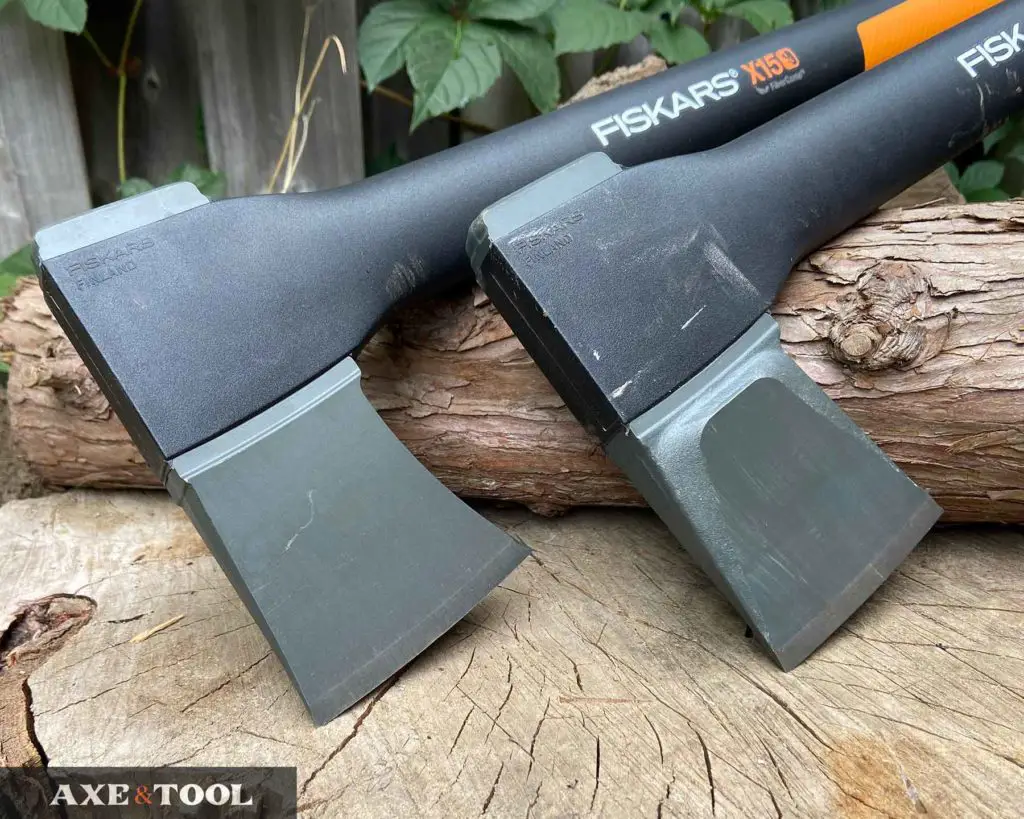
If you need a splitting axe, I suggest you switch to this article: Which Fiskars Splitting Axe is Right For You? It gets more in-depth on those models.
Fiskars chopping axes are for general use
The Fiskars chopping axe or “universal” axe is a general-use axe capable of chopping, limbing, felling, and small to medium splitting. It comes sharpened with a flat 30° grind and a stout wedge pattern head. The wedge shape is great for both busting chips when chopping and popping the grain apart when splitting.
In my experience the 28″ and 23″ chopping axes can chop or split up to around a 12” log. So they can fall a tree or break down firewood and can be used as a general “work axe”.
The hatchets all have “chopping” heads but are quite capable of any campsite or fireplace-level splitting needs.
The 17” chopping axes have a unique head shape compared to the rest. It has a thinner wedge shape that lends itself to more chopping “bushcraft” type of work and less to splitting (but there is a separate splitting version).
| Model | Length | Head Weight* | Tree/log size |
| 28″ Chopping axe | 28” | 2.25lb | 12” |
| X15 | 23” | 2.25lb | 12” |
| X10 | 17” | 1.75lb | 8” |
| X7 N7 Black 14″ | 14″ | 1lb | 6″ |
| X5 | 9.5″ | 1lb | 4″ |
* Head weight is approximate
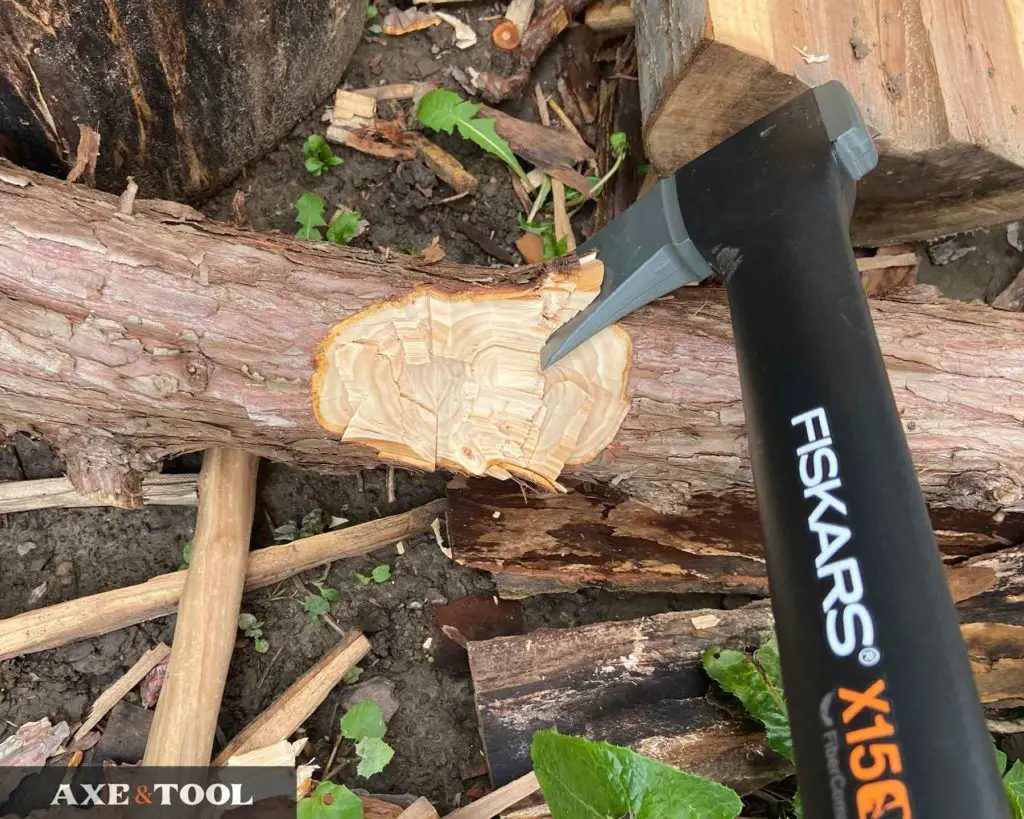
Fiskars Splitting axes are exceptional
Unlike the chopping axes, the splitting axes are only for splitting. But they are very popular because they are very effective and affordable. I think they are the best-value splitting axes on the market (and one of the best all-around).
The splitting heads have a wedge-shaped head with a 30° grind similar to the chopping axes, but with extended convex cheeks that flare out to split wood apart. The cheek shape allows for penetration before widening to spread the wood apart and creates less friction as the head passes through.

The large flares taper at the edges creating a leverage point so the axe can be twisted to pry stubborn wood apart. The composite handles are durable enough to withstand overstrikes, and can also be used to help pry.
While the splitting axes could be used to chop in a pinch, they won’t be able to cut very deep into the side of a log/tree because of the head shape.
There are 8 Fiskars splitting axes to choose from, they share 3 head weights.
| Model | Length | Head Weight* | Log Size |
| X27 36” Super Splitter | 36” | 4lb | 12-24+” |
| X25 | 29” | 4lb | 8-24” |
| X21 28” Splitting Axe | 28” | 2.5lb | 8-12” |
| X17 | 23.5” | 2.5lb | 6-12” |
| N12 | 19” | 1.75lb | 6-8” |
| X11 | 17 ⅜” | 1.75lb | 6-8” |
* Head weight is approximate
Choosing the right size of Fiskars axe
Choosing the size of an axe is about balancing power, mobility, and safety.
Basically, what will be a bigger pain: More swings when the work starts or carrying the extra size/weight?
There is typically a range of axes that could fit into any role, and it’s up to you what the right tradeoff is.
| Length | Typical use types |
| 36” | Homestead or cottage main splitter |
| 28” | Main splitter, property work axe, youth axe |
| 23.5” | Vehicle or compact property work axe |
| 17” | Camping, Bushcraft, Woodpile |
| 14” | Camping, Garden, Firepit, Backpacking |
| 9.5” | Backpacking |
The longer and heavier the axe, the more momentum it can build and the more potential power it can deliver. But the larger axes are less portable and harder to manipulate for detailed tasks.
Smaller axes and hatchets are easier to carry in a pack or use for detailed work. But it will take many more strikes, and be more fatiguing to chop/split larger pieces of wood.
Axe size and safety
Another consideration of an axe’s size is safety. And this may seem counterintuitive, but in general, the largest axes are the safest, especially for inexperienced users.
If you throw a bad swing with a 36” axe, or it ricochets off a log it’s very unlikely to come back and hit the user. The long handle means the blade is going to end up in the dirt.
28″, 23.5”, or 17″ axes will (or can) be used with two-handed swings and can put your legs/feet in the danger zone.Inexperienced axe users tend to chop in an arc motion, which can lead to a shorter axe hitting their toes/ankles/shins either off a bounce or just after passing through the wood.
Hatchets and one-handed axes also pose a danger to your off-hand if used incorrectly. Don’t hold the wood you are swinging at.
Orange vs Black-Handled Fiskars
You might notice there are a few versions of some Fiskars axes, and it can be hard to tell what’s different.
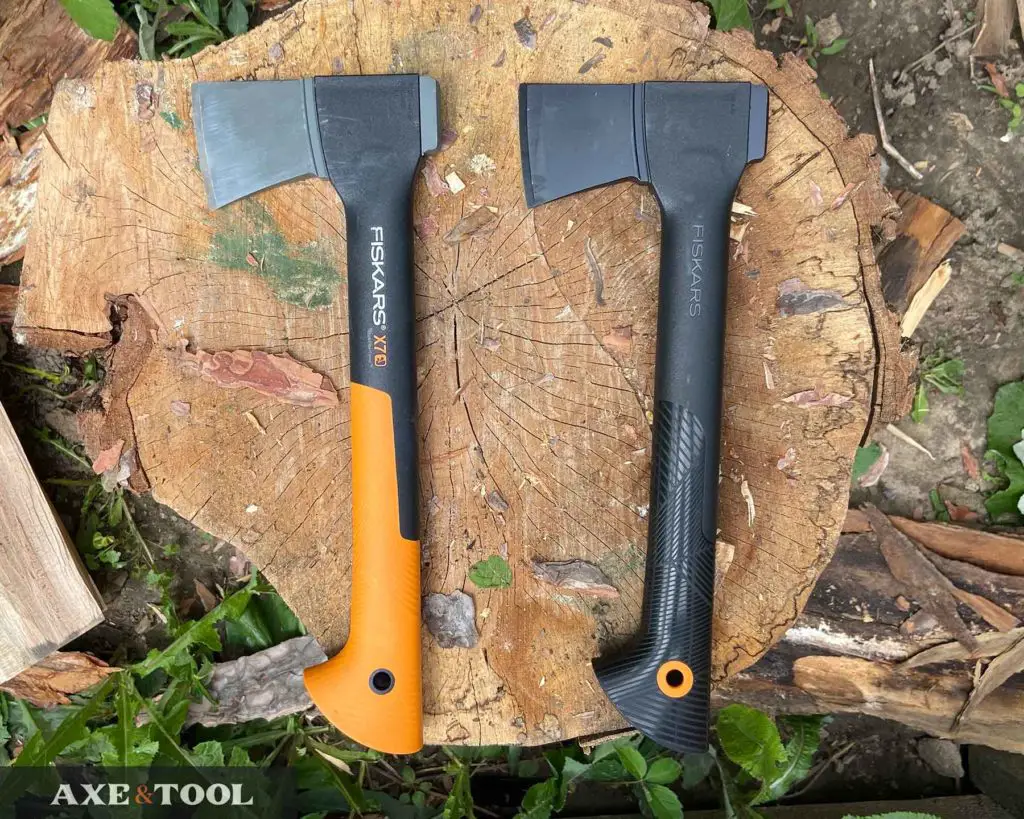
Fiskars X-series is the standard
The X-series is the primary Fiskars axe line. The blades are finished with a grey coating and the handles have a bright orange rubber overmold at the bottom of the grip area.
Fiskars X-series vs Black axes (A-series)
The black Fiskars axes (or A-series) are identical to orange-handled X-series models in length, head size, and design. The differences are a black coating on the head (not grey), and lack of rubber over-mold handle. However, the black 28” chopping and splitting axes are unique.
The Black 28” chopping axe is the only black axe that has no X-series counterpart.
The 28” black splitting axe matches the X21 which is not available in North America.
Get the X-series if you can, especially if it will be used for extended amounts of time, or in colder/wet weather. The over-mold reduces the feeling of vibration in your hands, improves grip, and is much less conductive of cold than the base handle material. It’s usually only a couple of bucks more than the black axes.
Fiskars Norden N-series are cool but expensive
In 2019 Fiskars launched the Norden hybrid line. The top of the handle around the head is still the same strong FiberComp injection molding, but it connects to a traditional hickory handle about a third of the way down.
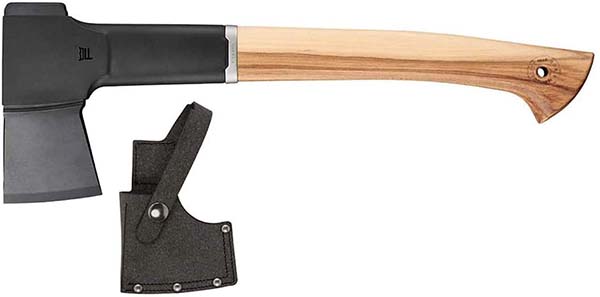
While they are interesting, these axes have never really spoken to me as they have the same head design, material, and performance as the X-series axes, but can cost 3 times more.
I also generally choose Fiskars when I don’t want to have to care about wood handles.
These axes come with a light and slim recycled leather sheath, making them more geared towards a pack axe.
Fiskars Axe Comparison (all models)
Fiskars large splitting axes

Fiskars X27 is the most popular splitter
The X27 is what I recommend to most people looking for a dedicated splitter.
The X27 and 36″ Black Super splitter are almost identical. Both are 36″ long with a large 4lb splitting head. The X27 is one of the most popular splitting axes on the market. These axes deliver the most splitting power and can split logs multiple feet wide.
Like I said earlier, I would choose the X27 over the black model every time because of the rubberized grip. It’s really thin, but it still helps reduce the vibration in your hands.
Fiskars X25 combines power and mobility
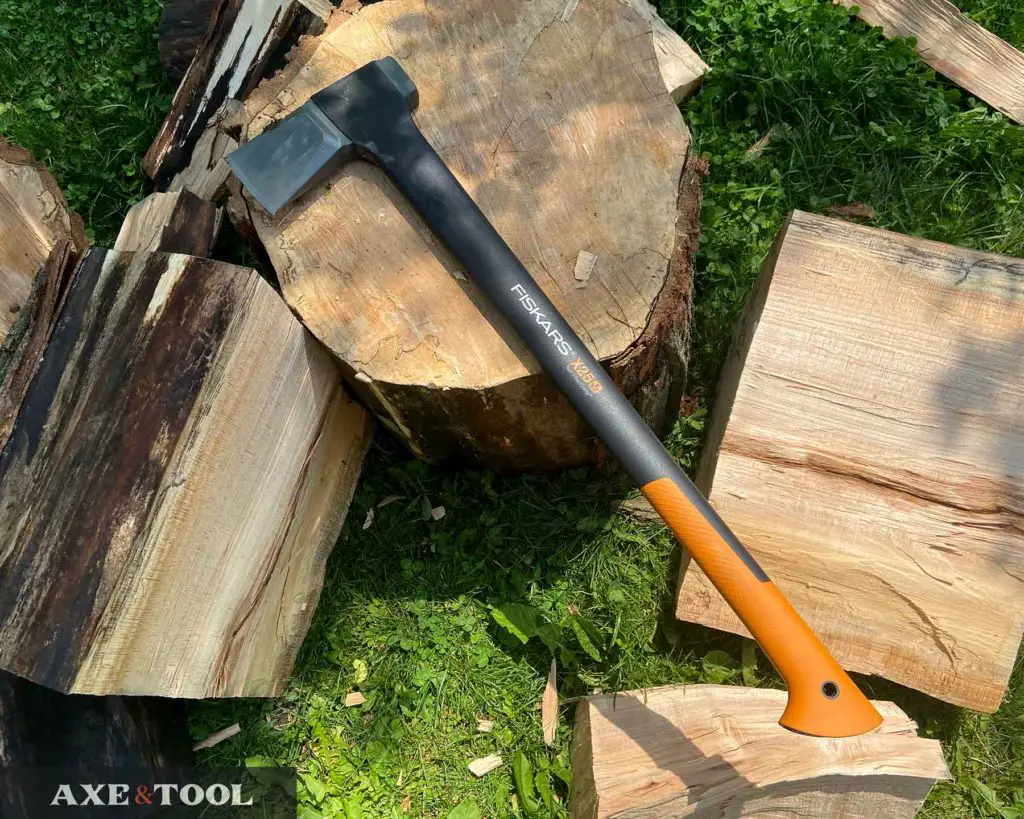
The X25 uses the same large splitting head as the X27 but on a 28″ handle. This still gives it enough power to tackle 24″+ logs, but also be mobile enough to aim precisely. This is my go-to splitter because it can be swung more frequently and accurately at the smaller pieces once the big logs are split.
However, I also have the benefit of grabbing the larger X27 or 8lb maul when things get really tough. If I just had to rely on just one splitting axe, I would go with the X27.
I like this axe, but be aware that it’s short enough to put your feet/shins in danger if you don’t use proper technique.
The IsoCore maul is for when things get tough

The large 8lb maul makes a great sidekick for really tough jobs, but it’s too big and heavy for splitting everything. For more details see Fiskars Splitting axes vs IsoCore Maul.
You can often get the maul pretty cheap (see on amazon), and it makes a great partner for your axe if you do have a lot of very large logs to split.
Mid-size Fiskars axe comparison
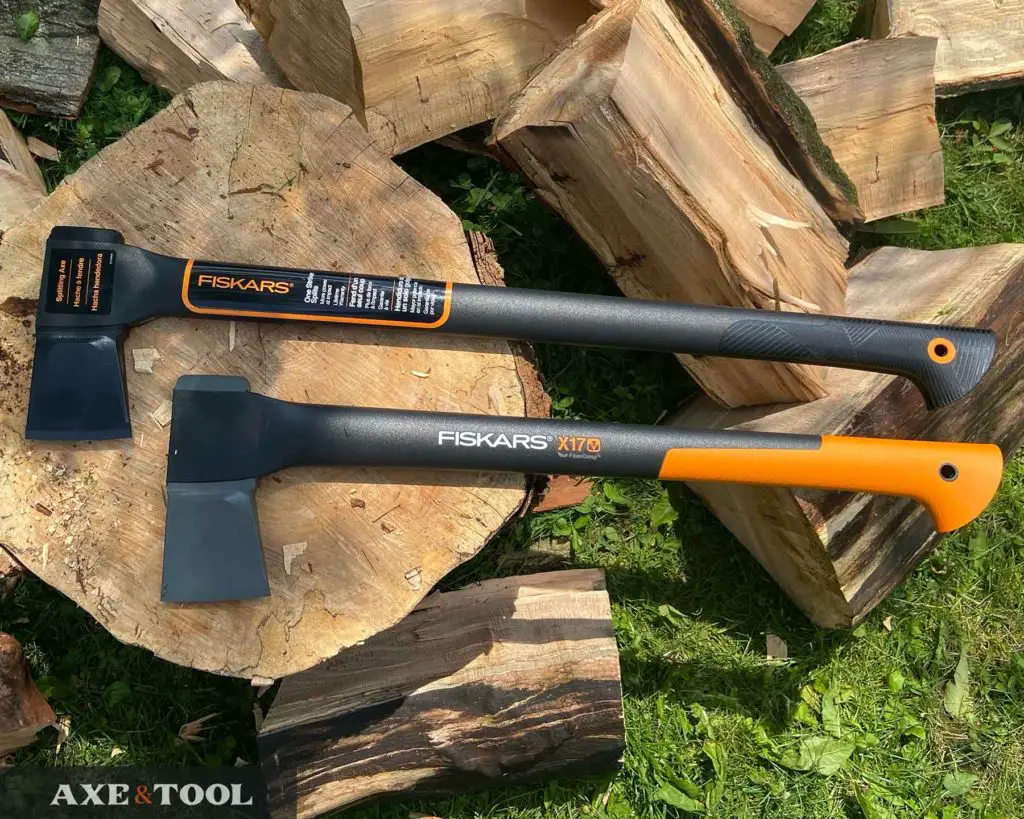
28″ Splitting axe or X21 make great splitters for youth
These splitting axes may be too small for the largest North American trees but can be quite handy around the woodpile or for mid-size trees. They have a light 2.5lb(ish) head that is capable of splitting a 12″ round (up to 16″ max). It’s light enough to be a great youth’s splitting axe.
The X21 is not available in North America, only the 28″ black splitting axe.
28″ Chopping axe is a jack of all trades (master of none)

This 28″ chopping axe is also known as the “universal” model internationally. It’s the largest Fiskars chopping axe with a 2.25lb (approx) wedge shape head. It is capable of felling trees, bucking wood, and splitting up to 12″ logs, making it a great general work axe.
It can fall trees but is not well balanced for horizontal swings, so it’s not great for using all day for this. But it can chop on the ground quite nicely.
There is no X-series version of this axe.
The compact X17 & X15 axes are perfect for vehicles

These axes have the same mid-size heads as their 28″ counterparts but on a 23.5″ handle. I love the X15 chopping axe – one lives in the trunk of my car year-round. It’s compact and good for walking around your property or strapping to an ATV but is too heavy for backpacking/bushcraft.
The X17 has a splitting head, and this is my least-used axe. I always just grab the X15, because it still splits the 12″ logs (maybe takes a swing or two more), but can also chop and fell.
Fiskars small axe and hatchet comparison

Fiskars X11 & Norden N12 are for the woodpile or camping
The X11 and Norden N12 have the same small splitting head that is capable of splitting up to 6-8″ logs. These make great little splitters for the woodpile as they can be used two-handed to break apart larger pieces or gripped higher with one hand for smaller tinder.
The X11 is 17.5″ long and the N12 is 20″ long with a hybrid wood handle.
They can make quick work of kindling on a campsite (and are probably a little bit overkill), but would work well in tandem with a saw for larger logs or some winter camping.
I would choose the X11 over the N12, simply because it’s half the price and so I don’t want to have to care for the wood handle (I have plenty of wood axes already).
Fiskars X10 / N10 & Gerber Freescape 17.5″

The 17″ chopping axes have a unique head shape compared to all other Fiskars axes. The blade is a thinner wedge before flaring slightly right before the handle. This makes it a better shape for Bushcraft-style chopping and shaping tasks. But it’s also still capable of splitting kindling. This makes a capable pack or camp axe.
The X10 is not commonly available in North America, so you will need to look for the Gerber Freescape 17.5 (Gerber is owned by Fiskars and the axe is identical).
Fiskars X7 is a classic go-to hatchet
The Fiskars X7 is massively popular and the standard Fiskars hatchet. It’s 14″ long and the stout wedge-shaped head is perfect for both chopping and splitting tasks.
The X7 would be my first choice for a kindling hatchet, car camping, and yard work. It’s very well-designed and ridiculously affordable.
I would choose the X7 over the black, Gerber, or Norden versions. I like the overmold grip, and the X7 is just such a great price (the Gerber usually costs more).
The X5 mini hatchet is perfect for your pack
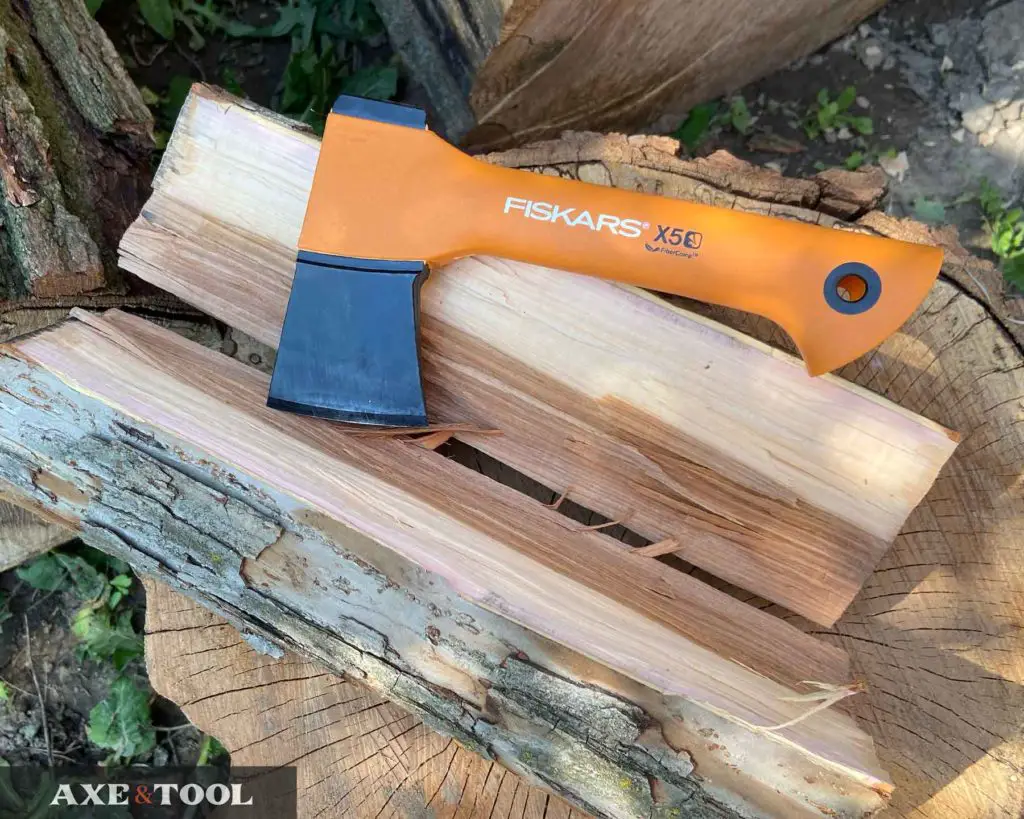
The X5 is surprisingly quite good at splitting kindling and chopping wood. It is my favorite as an ultra-compact hatchet for backpacking (even over some of the more expensive options). It only weighs 0.56kg (1.3lbs), which makes it the lightest “real” axe out there. (see my article X5 vs Gerber Pack Axe)
It uses the same head as the X7, it’s just on a 9.5″ handle. To use it feels like your knuckles are at risk when splitting (though I have never hit them), and you lose prying ability for wood that doesn’t split first hit.
Depending on your pack consider the X7 even for backpacking. It is longer, but it only weighs 0.2lbs (3oz) more and you get a lot more capability and leverage.
There is a black Gerber branded version of this axe that can often be easier to find in USA/Canada. Here is the Gerber 9 on Amazon.
Please comment below If I missed something or if you have any questions. I do my best to respond to everyone.
About the author:
About the author:
Jim Bell | Site Creator
I’m just a guy who likes axes. I got tired of only finding crap websites, so I set out to build a better one myself.
I’m also on Instagram: @axeandtool



Hello. How does the black 28″ Black Chopping Axe compare in terms of the axe’s head size. I’m trying to find a sheath, and no one lists the dimensions. Thanks in advance.
It’s the same size as the X15 (if that helps) – or 3.5″ cutting edge, 3.25″(ish) from the edge to the handle, and the whole head from front to back is 6.75″.
This was really helpful and informative, Thank you.
Sounds like you’d go for the X7 vs the X10/Gerber 17.5″ for a hatchet? I need something for campsites for my van. Thinking the extra length would be better on the X10 but keeps the chopping head instead of the splitting heads of X11?
Honestly, I go back and forth between the two quite a bit. I think for van camping I would probably take the larger X10/Gerber or X11 (I took the X11 quite a bit last year). When I do walk in camping I would take the X7. Love them both, but if you have space the extra weight goes a long way.